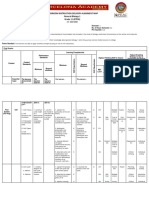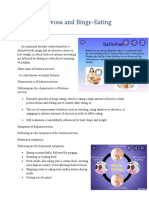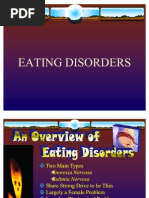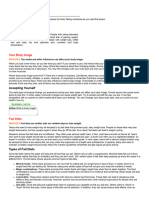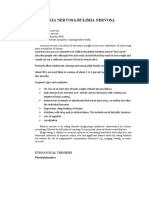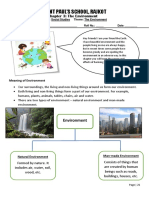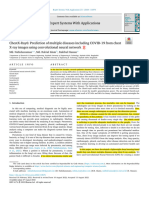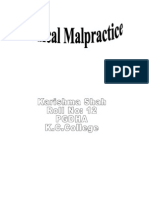0 ratings0% found this document useful (0 votes)
80 viewsEXSC 191 Exam 1
EXSC 191 Exam 1
Uploaded by
kimber brown1. Physical activity is any activity above basal metabolic rate, while guidelines recommend at least 60 minutes per day for children.
2. Determinants of health include genetics, environment, gender, and other factors outside of our control.
3. Lifestyle changes and increases in non-communicable diseases have led to differences in causes of death over the last 100 years.
Copyright:
© All Rights Reserved
Available Formats
Download as DOCX, PDF, TXT or read online from Scribd
EXSC 191 Exam 1
EXSC 191 Exam 1
Uploaded by
kimber brown0 ratings0% found this document useful (0 votes)
80 views3 pages1. Physical activity is any activity above basal metabolic rate, while guidelines recommend at least 60 minutes per day for children.
2. Determinants of health include genetics, environment, gender, and other factors outside of our control.
3. Lifestyle changes and increases in non-communicable diseases have led to differences in causes of death over the last 100 years.
Copyright
© © All Rights Reserved
Available Formats
DOCX, PDF, TXT or read online from Scribd
Share this document
Did you find this document useful?
Is this content inappropriate?
1. Physical activity is any activity above basal metabolic rate, while guidelines recommend at least 60 minutes per day for children.
2. Determinants of health include genetics, environment, gender, and other factors outside of our control.
3. Lifestyle changes and increases in non-communicable diseases have led to differences in causes of death over the last 100 years.
Copyright:
© All Rights Reserved
Available Formats
Download as DOCX, PDF, TXT or read online from Scribd
Download as docx, pdf, or txt
0 ratings0% found this document useful (0 votes)
80 views3 pagesEXSC 191 Exam 1
EXSC 191 Exam 1
Uploaded by
kimber brown1. Physical activity is any activity above basal metabolic rate, while guidelines recommend at least 60 minutes per day for children.
2. Determinants of health include genetics, environment, gender, and other factors outside of our control.
3. Lifestyle changes and increases in non-communicable diseases have led to differences in causes of death over the last 100 years.
Copyright:
© All Rights Reserved
Available Formats
Download as DOCX, PDF, TXT or read online from Scribd
Download as docx, pdf, or txt
You are on page 1of 3
What is Physical Activity?
Any activity above basal metabolic
BMI +40
Morbid obesity
60+ min of PA/day
Guideline for children
Determinants of health of which we have little or no control
Genetics, environment, gender, disability, age, healthcare availability
The general difference between causes of death today compared to 100 years ago
Poor lifestyle, increases in non-communicable diseases, chronic diseases
Commonly considered the MOST effective strategy for injury prevention
Shoe selection
Component of Exercise: improves venous return from working muscles, normalizes CV system, and
reduces metabolic byproducts
Cool down
Soreness occurring 24-48 hours after a workout when the principle of progression is violated
Delayed onset muscle soreness
Population requiring medical clearance prior to starting an exercise program
Inactive women age 50+ or men age 40+
Life threatening condition: pulse is throbbing, sweating has ceased, severe headache & dizziness,
jumbled speech
Heat stroke
The "R" in SMART goal
Realistic
Task-specific form of self-confidence in overcoming barriers to accomplish goals
Self-efficacy
The factor that has the greatest effect on self-efficacy and overall likelihood for success
Past experiences
This stage of change involves not being interested in becoming more active and defensive, "not active,
don't want to be"
Precontemplation
This form of motivation involves obtaining an external reward or avoiding external punishment
External regulation
The caloric value of fat
9kcal/gram
The rate at which your body uses energy at rest
Basal metabolic rate
A measure of the amount of nutrients to the amount of calories
Nutrient density
A mineral drawn form the bones in the case of an excessively high protein diet
Calcium
This nutrient binds to and excretes fat, lowers cholesterol and blood sugar, is obtained through fruits
Soluble fiber
A sign of malnutrition that can be partially due to inadequate psychosocial stimulation
Stunting
Condition characterized by excessive weight loss including muscle wasting
Cachexia
A condition of too few carbohydrates resulting in very acidic circulating blood, ultimately causing
damage to multiple body systems
Ketosis
Consequences of excessive fat intake
Depression, stress, sex hormone dysfunction, cancer risk, cognitive deficits
Sodium drops to dangerous levels, renal system becomes overwhelmed, and brain swells (causing
cognitive deficits, seizures or coma)
Water intoxication
Psychological sources of stress
Perfectionsistic atttiufes or obsessiveness
The functions or cortisol
Immobolize the non-essiental functions, increases in long-term blood glucose and muscle tension
Know the stress hormones and response
This type of exercise can increase anxiety symptoms
Vigorous strength training
Overtraining, exercise dependence
Negative effects on well-being
Recommend complex cbars, more protein, avoid dehydration , limit caffeine and alcohol
Diet for anxiety
Be aware of medications, avoid excess alcohol, avoid vigorous PA at end of day, avoid naps
Sleep guidelines
Effects of exercise on stress management
Reduced recovery and/or reduced reactivity
This type of distorted thinking involves identifying with your shortcomings
Labeling
Tendency to overcommit, fear of failure/change, overwhelming tasks, unappealing tasks
Procrastination
This coping strategy is most effective for handling stressors out of our control
Emotion focused coping
This "runs the show" when in faced with a challenge
Emotions
Reasons why one can't "tough it out"
Too much parental stress, unfulfilled basic needs, or too little stress
Name and describe a way fear can affect performance
Making you sick, stops progress, makes you stop trying, is distracting, hypnotizing, or ruins
judgement
Obsessive worry with perceived consequences of losing
Fear of failure
The definition of "flexibility" as a marker of toughness
The ability to summon positive emotions and remaining emotionally balanced
Name 2 ways social support can potentially increase stress levels
Support becomes too controlling and develops dependency
You might also like
- Pediatric Mock Resuscitation ScenariosDocument6 pagesPediatric Mock Resuscitation ScenariosdinkytinkNo ratings yet
- Atomic Rex A Kaiju Thriller (Matthew Dennion) (Z-Library)Document163 pagesAtomic Rex A Kaiju Thriller (Matthew Dennion) (Z-Library)Strictly Aviator Amritansh VermaNo ratings yet
- Exsc 223 Practice Exam 2Document11 pagesExsc 223 Practice Exam 2kimber brownNo ratings yet
- Dick Sutphen How To Fix Everything in Your Life at OnceDocument130 pagesDick Sutphen How To Fix Everything in Your Life at OnceMaradine Tep100% (2)
- Exsc FinalDocument11 pagesExsc Finalkimber brownNo ratings yet
- Exsc Practice Exam 3Document12 pagesExsc Practice Exam 3kimber brownNo ratings yet
- Classroom Instruction Delivery Alignment Map General Biology 1 Grade 11 (STEM)Document6 pagesClassroom Instruction Delivery Alignment Map General Biology 1 Grade 11 (STEM)JunedelMirallesPerez67% (3)
- Positive and Negative Health Behaviors Associated With StresDocument18 pagesPositive and Negative Health Behaviors Associated With StresNadia AhmedNo ratings yet
- 100 Tips for an Active Age: Your guide to health, happiness and lifelong learningFrom Everand100 Tips for an Active Age: Your guide to health, happiness and lifelong learningNo ratings yet
- Module No. 6 NCM 117Document33 pagesModule No. 6 NCM 117Jean Paula PorrasNo ratings yet
- Health Psychology Ppt Group 6Document49 pagesHealth Psychology Ppt Group 6zoya.malikzm6649No ratings yet
- Eating Disorder PPT by Shreyasi MittalDocument35 pagesEating Disorder PPT by Shreyasi MittalPrachi gattaniNo ratings yet
- Anorexia Nervosa: Cultural PressuresDocument8 pagesAnorexia Nervosa: Cultural PressuresAbigial MiraNo ratings yet
- Cortisol Blueprint 2024Document4 pagesCortisol Blueprint 2024dipuunique6No ratings yet
- Quality of Life in Cancer: by Sanish SebastianDocument55 pagesQuality of Life in Cancer: by Sanish Sebastiansanish4u100% (1)
- What Is Cancer FatigueDocument7 pagesWhat Is Cancer FatigueBucur ClaudiaNo ratings yet
- EnglishDocument15 pagesEnglishirene mokNo ratings yet
- REPORTDocument68 pagesREPORTVIVIEN CONSIGNANo ratings yet
- Shubham Practical TwoDocument7 pagesShubham Practical TwoMaanu VermaNo ratings yet
- Eating DisorderDocument47 pagesEating DisorderRujuta BaramateNo ratings yet
- Bulimia Nervosa and BingeDocument7 pagesBulimia Nervosa and Bingeizza ghafoorNo ratings yet
- Adolescence Nutrition & ObesityDocument52 pagesAdolescence Nutrition & ObesityTawfek RedaNo ratings yet
- Presentation To NHFDocument45 pagesPresentation To NHFDonna WhiteNo ratings yet
- What Is AnorexiaDocument3 pagesWhat Is Anorexiaelizabeth.arockiadassNo ratings yet
- Vitality & LongevityDocument32 pagesVitality & LongevityFarah FayaNo ratings yet
- Anorexia NervosaDocument6 pagesAnorexia NervosaAmina IftikharNo ratings yet
- Guidance and Counselling AssignmentDocument9 pagesGuidance and Counselling AssignmentDaniel KiptuikongNo ratings yet
- Women and Mental HealthDocument91 pagesWomen and Mental HealthSreelekhaNo ratings yet
- PE098746812Document7 pagesPE098746812weebmyphone11No ratings yet
- Geriatric NutritionDocument24 pagesGeriatric NutritionMichael Wijaya100% (2)
- Stress ManagementDocument83 pagesStress ManagementianNo ratings yet
- Health of Your Body and Self 7-1Document15 pagesHealth of Your Body and Self 7-1karthikxkarthik365No ratings yet
- HealthDocument2 pagesHealthgloriaademola0No ratings yet
- Local Media1245699107962459948-4Document10 pagesLocal Media1245699107962459948-4Ellen Grace GenetaNo ratings yet
- English ProjectDocument26 pagesEnglish Projectosmanajjona182No ratings yet
- Dick Sutphen - Fix Everything in Your Life at Once - 01 - Increase Energy PDFDocument8 pagesDick Sutphen - Fix Everything in Your Life at Once - 01 - Increase Energy PDFtempullybone100% (1)
- AbnormalbrainchangesDocument112 pagesAbnormalbrainchangesPANI78No ratings yet
- Eating DisordersDocument8 pagesEating DisordersSandraNo ratings yet
- Bulimia NervosaDocument7 pagesBulimia NervosaLiza De Lara OcampoNo ratings yet
- Eating DisordersDocument46 pagesEating Disordersedrinsne100% (1)
- Nutrition, Mental Health, and Behavior Change: Rethinking The Current Model of HealthDocument33 pagesNutrition, Mental Health, and Behavior Change: Rethinking The Current Model of Healthlife psychology in tamilNo ratings yet
- Deportes 2 - MergedDocument12 pagesDeportes 2 - Mergedxbpmh4nsjrNo ratings yet
- Stress ManagementDocument24 pagesStress Managementbharath19921342No ratings yet
- Eating DisordersDocument40 pagesEating DisordersLauraysha McMillanNo ratings yet
- Geriatric NursingDocument46 pagesGeriatric NursingQuolette Constante100% (2)
- Health Professionals Self-Help Well-BeingDocument7 pagesHealth Professionals Self-Help Well-BeingMika TiuNo ratings yet
- Healthy AgingDocument7 pagesHealthy AgingAryaa ArrNo ratings yet
- Eating DisordersDocument16 pagesEating Disordersapi-414600863No ratings yet
- HyperthyroidismDocument4 pagesHyperthyroidismavinash dhameriyaNo ratings yet
- Body Image and Eating Disorders ReadingDocument3 pagesBody Image and Eating Disorders Readingwilbercanizales422No ratings yet
- 2.2 Obesity Malnutrition, Adulteration in Food Environmental Sanitation Explosive PopulationDocument9 pages2.2 Obesity Malnutrition, Adulteration in Food Environmental Sanitation Explosive PopulationreddyapdscNo ratings yet
- Anorexia Nervosa/Bulimia Nervosa: Dsm-IvDocument5 pagesAnorexia Nervosa/Bulimia Nervosa: Dsm-IvNicolo Paulo TabiraraNo ratings yet
- End Premature Ejaculation: Last Longer Tonight with These Proven TechniquesFrom EverandEnd Premature Ejaculation: Last Longer Tonight with These Proven TechniquesNo ratings yet
- Mental Health AwarenessDocument2 pagesMental Health AwarenessAnita Kiara100% (1)
- Module 20: Eating Disorders: When Is The Help of A Professional Necessary?Document3 pagesModule 20: Eating Disorders: When Is The Help of A Professional Necessary?MordecalexNo ratings yet
- Teachers and StressDocument11 pagesTeachers and StressKrishan KantNo ratings yet
- Peh1 ReviewerDocument6 pagesPeh1 ReviewerPrincess Angelica NavarraNo ratings yet
- Stress and Physical ActivityDocument21 pagesStress and Physical Activityaeirianloueli20No ratings yet
- UNIT VIII Eating DisordersDocument7 pagesUNIT VIII Eating Disorderspearlcomputer079No ratings yet
- PDHPE Exam RevisionDocument11 pagesPDHPE Exam RevisionjoshuabonelloNo ratings yet
- The Impact of Good HealthDocument5 pagesThe Impact of Good HealthavasiNo ratings yet
- Obesity ManagementDocument44 pagesObesity Managementbelal mahmoudNo ratings yet
- Biology 101 Exam 1 Review-2Document4 pagesBiology 101 Exam 1 Review-2kimber brownNo ratings yet
- Fall 2020 CHEM 112 Exam 3 Practice ProblemsDocument12 pagesFall 2020 CHEM 112 Exam 3 Practice Problemskimber brownNo ratings yet
- Chapter 17Document2 pagesChapter 17kimber brownNo ratings yet
- Chapter 18 Practice Problems and AnswersDocument2 pagesChapter 18 Practice Problems and Answerskimber brownNo ratings yet
- SI Session 2-23-21 WorksheetDocument2 pagesSI Session 2-23-21 Worksheetkimber brownNo ratings yet
- The Pill Opened My Eyes To The Discrimination Women Faced When Trying To Have AnDocument3 pagesThe Pill Opened My Eyes To The Discrimination Women Faced When Trying To Have Ankimber brownNo ratings yet
- Dance Exam 3Document7 pagesDance Exam 3kimber brownNo ratings yet
- Dance Exam 2Document8 pagesDance Exam 2kimber brownNo ratings yet
- Exam 1 DANC 101Document5 pagesExam 1 DANC 101kimber brownNo ratings yet
- Joints Classification WorksheetDocument1 pageJoints Classification Worksheetkimber brownNo ratings yet
- EXSC 224 Problems To PonderDocument3 pagesEXSC 224 Problems To Ponderkimber brownNo ratings yet
- Exsc 223 Chapter 23 Practice ExamDocument5 pagesExsc 223 Chapter 23 Practice Examkimber brownNo ratings yet
- Exsc 223 CH 9 Practice ExamDocument8 pagesExsc 223 CH 9 Practice Examkimber brownNo ratings yet
- Exsc 223 CH 24 Practice ExamDocument4 pagesExsc 223 CH 24 Practice Examkimber brownNo ratings yet
- EXSC 223 Exam 1 ReviewDocument5 pagesEXSC 223 Exam 1 Reviewkimber brownNo ratings yet
- Case No. 5 Rle - PernitoDocument4 pagesCase No. 5 Rle - PernitoAlecxia Nicole PernitoNo ratings yet
- Time ManagementDocument8 pagesTime ManagementManpreet BhullarNo ratings yet
- Major Depression in Primary Care: Making The Diagnosis: RticleDocument6 pagesMajor Depression in Primary Care: Making The Diagnosis: RticleMarnitha Bato'sau'No ratings yet
- Fitness Choices and First Aid Study NotesDocument11 pagesFitness Choices and First Aid Study NotesAlan VanNo ratings yet
- The Somatic Connection: Manual Therapy Shown To Be Effective For Tension-Type HeadacheDocument7 pagesThe Somatic Connection: Manual Therapy Shown To Be Effective For Tension-Type Headachemk78_inNo ratings yet
- Occupational Safety and HealthDocument4 pagesOccupational Safety and HealthCatiereign VerdeNo ratings yet
- Vitamin K2, Vitamin D, and Calcium: A Winning ComboDocument5 pagesVitamin K2, Vitamin D, and Calcium: A Winning ComboMichele Rossi100% (1)
- Maternity Consent Video Script UPDATED 01.05.2024Document8 pagesMaternity Consent Video Script UPDATED 01.05.2024Agostina MiniNo ratings yet
- Sedative Hypnotic PoisoningDocument37 pagesSedative Hypnotic PoisoningDeepa WilliamNo ratings yet
- Introduction To ECG For NursingDocument75 pagesIntroduction To ECG For NursingRashid AlHamdan100% (1)
- Secrets of The SiddhasDocument1 pageSecrets of The SiddhasChiranth ChandNo ratings yet
- Ijams October 12 23Document12 pagesIjams October 12 23kentryzbustamanteNo ratings yet
- J Vet Emergen Crit Care - 2012 - Brainard - RECOVER Evidence and Knowledge Gap Analysis On Veterinary CPR Part 5Document20 pagesJ Vet Emergen Crit Care - 2012 - Brainard - RECOVER Evidence and Knowledge Gap Analysis On Veterinary CPR Part 5sebastian Jimenez PNo ratings yet
- NCM 103 Instructional PlanDocument5 pagesNCM 103 Instructional PlanShandz de Rosas100% (1)
- Nursing Theory I Obstetric and Pediatric Nursing CURRICULUM (PDFDrive)Document201 pagesNursing Theory I Obstetric and Pediatric Nursing CURRICULUM (PDFDrive)HasNo ratings yet
- Dermatology USMLE Step 1, 2 NotesDocument10 pagesDermatology USMLE Step 1, 2 NotesitzjuliiaNo ratings yet
- Human A&P 2 final exam study guideDocument8 pagesHuman A&P 2 final exam study guideLydia DennisNo ratings yet
- Anorexia NervosaDocument7 pagesAnorexia NervosaEsther XiaToong LauNo ratings yet
- Practice Tests - For TuesdayDocument92 pagesPractice Tests - For Tuesday2004 2810No ratings yet
- Saint Paul'S School, Rajkot: Chapter 3: The EnvironmentDocument8 pagesSaint Paul'S School, Rajkot: Chapter 3: The EnvironmentVasoya ManojNo ratings yet
- Pat Coleby On Vitamin C Treatment For SNAKE BITES Here) Did Much Research On The Use of Vitamin C On Humans. in Turn A Californian VetDocument2 pagesPat Coleby On Vitamin C Treatment For SNAKE BITES Here) Did Much Research On The Use of Vitamin C On Humans. in Turn A Californian VetharoldpsbNo ratings yet
- 1 s2.0 S0957417422016372 MainDocument14 pages1 s2.0 S0957417422016372 MainMd NahiduzzamanNo ratings yet
- (Coll.) WHO Classification of Head and Neck Tumour (B-Ok - Xyz)Document285 pages(Coll.) WHO Classification of Head and Neck Tumour (B-Ok - Xyz)Andrea GonzalezNo ratings yet
- Medical Malpractice - AssignmentDocument20 pagesMedical Malpractice - Assignmentk123s100% (1)
- Instant Access to (Ebook) Taking Development Seriously A Festschrift for Annette Karmiloff-Smith: Neuroconstructivism and the Multi-Disciplinary Approach to Understanding the Emergence of Mind by Michael S. C. Thomas, Denis Mareschal, Victoria Knowland ISBN 9781138334052, 1138334057 ebook Full ChaptersDocument61 pagesInstant Access to (Ebook) Taking Development Seriously A Festschrift for Annette Karmiloff-Smith: Neuroconstructivism and the Multi-Disciplinary Approach to Understanding the Emergence of Mind by Michael S. C. Thomas, Denis Mareschal, Victoria Knowland ISBN 9781138334052, 1138334057 ebook Full Chaptersuritaraginvs100% (2)
- s12888 019 2077 8Document9 pagess12888 019 2077 8baynaNo ratings yet
- Corneal Topography: Presented by Maj Anjani Kumar Resident (Ophth)Document71 pagesCorneal Topography: Presented by Maj Anjani Kumar Resident (Ophth)Yaman Muhaisen100% (1)






